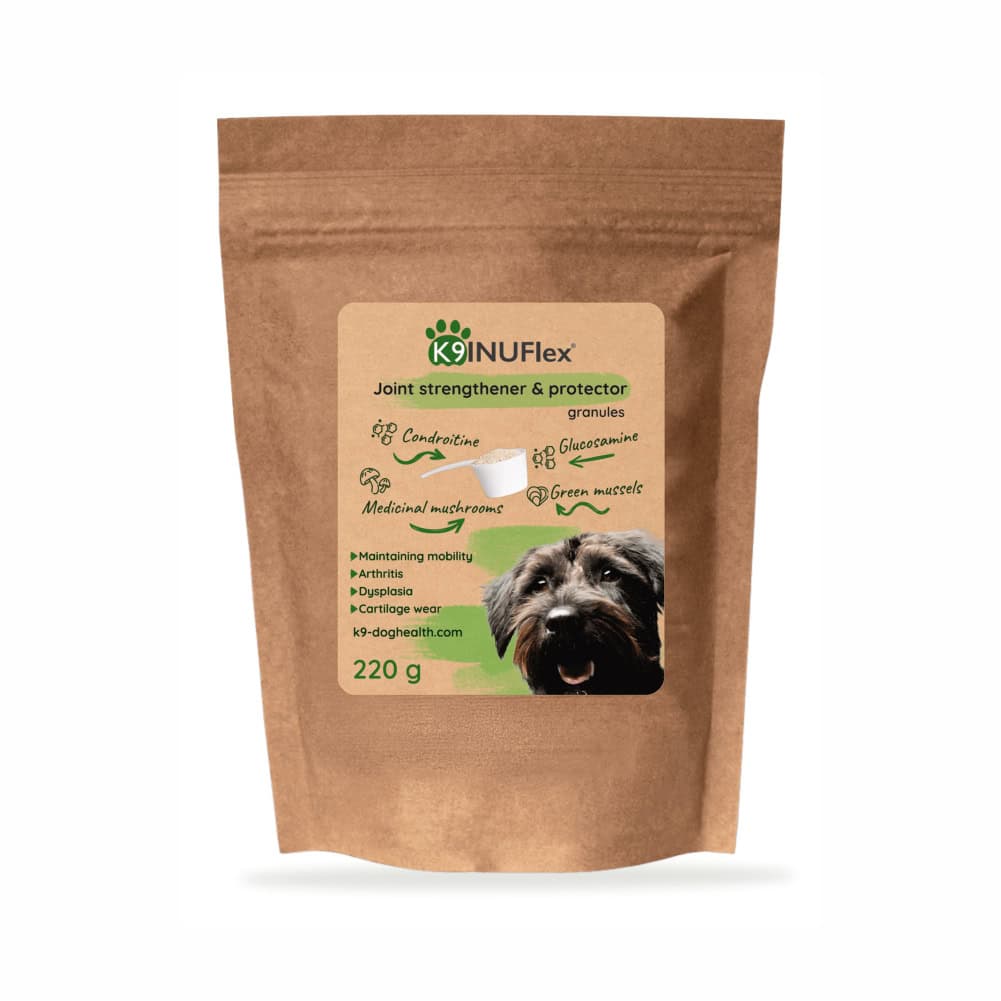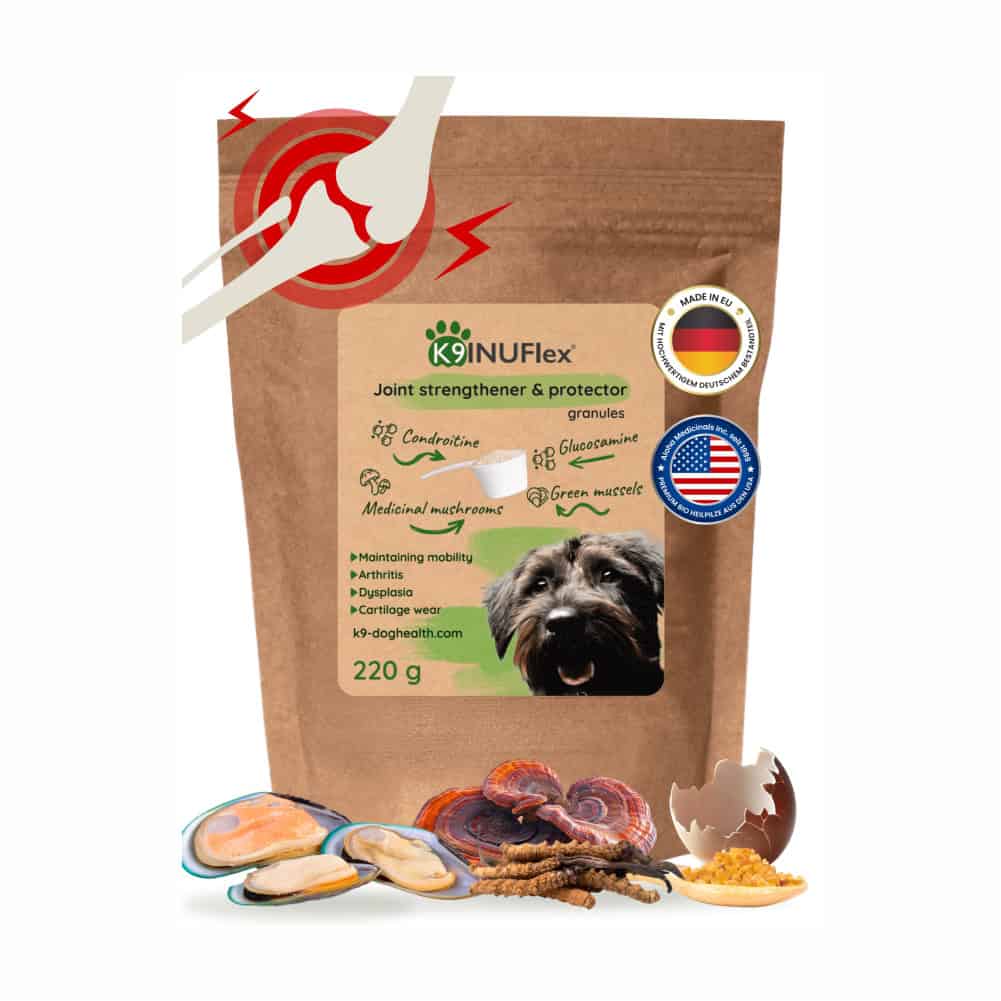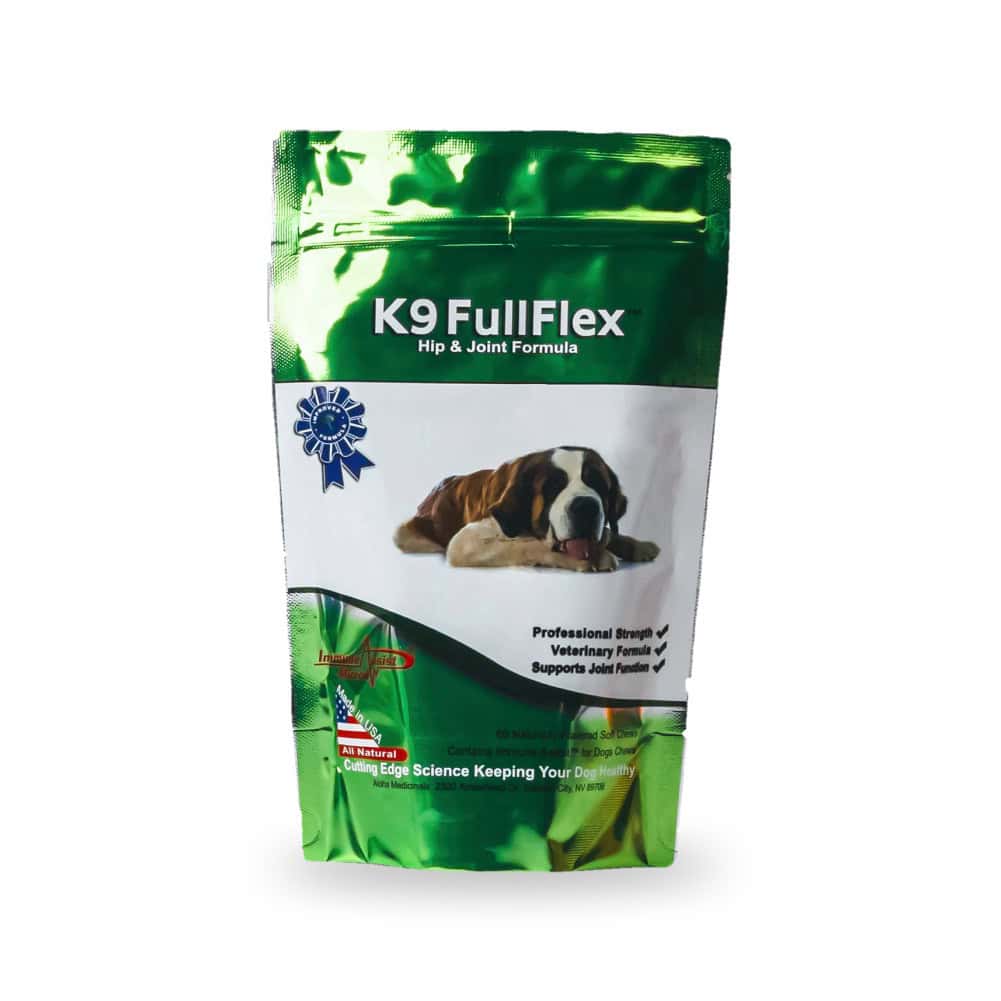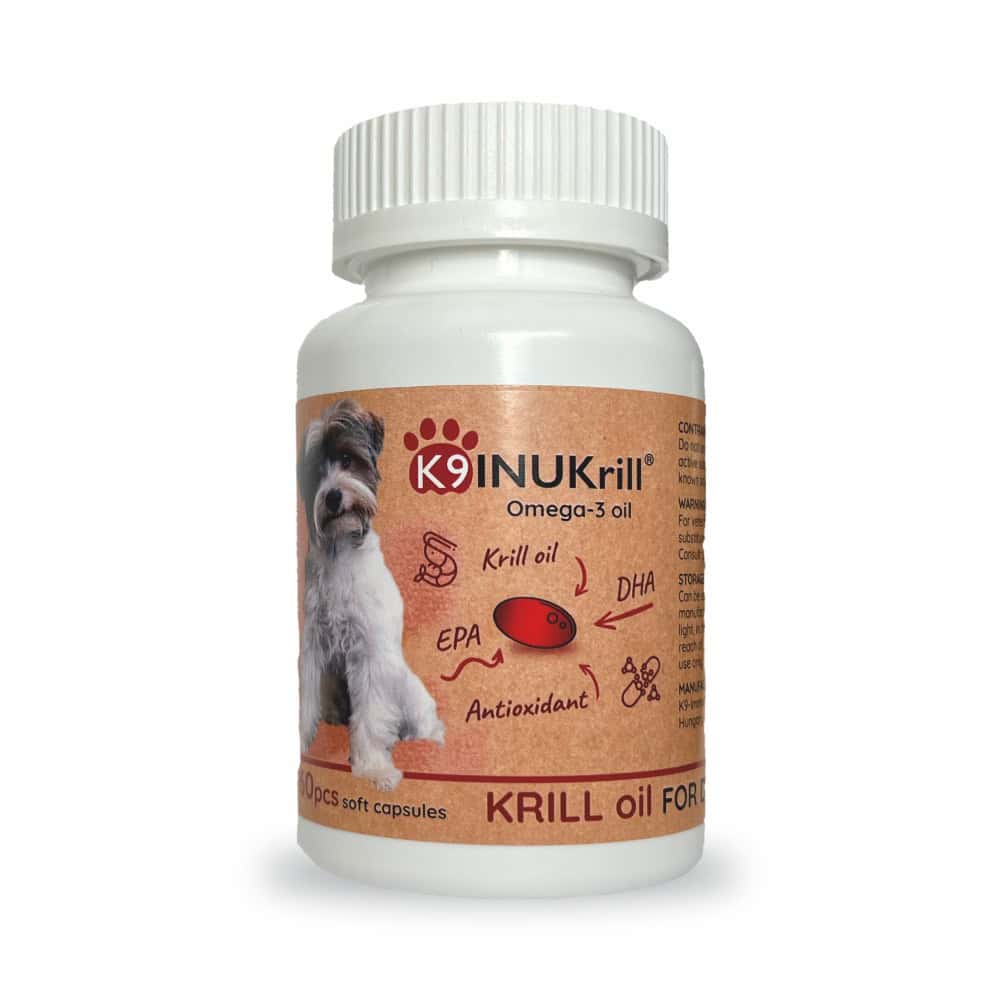Canine osteoarthritis (also known as joint degeneration or osteoarthrosis) is among the most common musculoskeletal problems in dogs, especially in older, large-breed or over-worked companions. The condition develops slowly and gradually. Although it cannot be reversed entirely, with proper attention, nutrition and exercise it can be managed effectively for the long term.
What is canine osteoarthritis?
In healthy dogs, the breakdown and rebuilding of joint cartilage are in balance. However, in canine osteoarthritis this balance is disrupted, and the breakdown processes begin to dominate. As a result, the cartilage loses its water content, its elasticity disappears, and the joint surfaces start rubbing against each other. Over time, this gradual friction leads to inflammation, pain, and eventually reduced mobility.
Types of osteoarthritis
- Primary (age-related) osteoarthritis: the natural wear and tear of cartilage with advancing age.
- Secondary osteoarthritis: develops due to injury, dysplasia, joint inflammation or excess weight.
Why does osteoarthritis develop in dogs?
Several factors play a role in the development of canine osteoarthritis. Some are hereditary, while others can be improved through conscious care.
Main causes and risk factors
- Genetic predisposition: large-breed dogs (Labrador, Golden Retriever, German Shepherd, Rottweiler) are especially prone.
- Excess weight: excess pounds constantly strain the joints and accelerate cartilage wear.
- Age: as age advances, cartilage cell regeneration slows down.
- Lack of exercise or over-exertion: both inactivity and excessive stress are harmful.
- Previous injuries: dislocations, fractures, dysplasia lead to uneven joint loading.
- Nutrient deficiency: if the diet lacks sufficient joint-supportive nutrients (e.g. glucosamine, collagen).
Which dogs are most at risk?
Large-breed, fast-growing dogs, dogs with higher body weight or sedentary pets, and those with previous orthopedic issues are at higher risk. Moreover, neutering may affect cartilage metabolism, so joint health may require special attention.

Symptoms of osteoarthritis in dogs
- Stiffness, difficulty rising especially after rest
- Avoiding stairs or jumping
- Limping, restricted movement
- Reduced activity, rejecting play
- Painful, swollen joints
Symptoms may start mild but become more pronounced over time. With early detection the joint status can be stabilised and the process slowed down.
Diagnosis and examinations
Veterinary diagnosis is based on a physical examination, but accurate assessment requires imaging (X-ray, CT, MRI). The internationally recognised COAST (Canine Osteoarthritis Staging Tool) system now helps determine the stage of the disease. For early detection, owner-filled mobility- and pain-assessment questionnaires are also useful.
Treatment of osteoarthritis in dogs
Medication and veterinary therapy
The goals of treatment are pain reduction, inflammation control, and slowing cartilage breakdown. To achieve these objectives, the veterinarian may prescribe non-steroidal anti-inflammatory drugs (NSAIDs) as well as joint-protective formulations. In more advanced or severe cases, orthopaedic surgery or even joint replacement may therefore be considered.
Regenerative and modern therapies
The latest approaches include stem-cell therapy and exosome treatment, which aim to stimulate cartilage cell regeneration. Meanwhile, promising results have emerged for CBD oil and monoclonal antibodies, which reduce pain and inflammation.
Key actives for dogs with osteoarthritis
Glucosamine & chondroitin
Glucosamine and chondroitin-sulphate are fundamental building blocks of cartilage. They help maintain the cartilage’s water content and elasticity and inhibit cartilage-degrading enzymes. Their combined use enhances joint fluid quality and reduces inflammatory pain.
Hyaluronic acid
Hyaluronic acid is a natural component of joint fluid, providing lubrication and friction-free movement. Available as injection or orally administered form, it supports restoring the density of the joint fluid.
Collagen
Collagen underpins the elasticity of cartilage and connective tissue. Hydrolysed forms can be supplemented, supporting cartilage regeneration and strengthening ligaments.
Egg-shell membrane (ESM)
Egg-shell membrane (ESM) is a natural source of collagen, hyaluronic acid and glycosaminoglycans. It also includes chondroitin-sulphate, keratin and natural enzymes – making it uniquely comprehensive in supporting cartilage, tendons and ligaments.
Omega-3 fatty acids
Omega-3 fatty acids (especially EPA and DHA) have been proven to reduce joint inflammation and slow down osteoarthritis progression. Sources include krill oil, fish oil or flaxseed oil. Regular supplementation complements the effect of glucosamine and chondroitin, and ranks among the most effective natural joint support options for dogs.
MSM (methyl-sulfonyl-methane)
MSM is a natural source of sulphur with anti-inflammatory and antioxidant effects. It supports connective tissue regeneration, reduces joint pain and helps preserve mobility. Regular use can reduce inflammatory processes and effectively complement cartilage-protective supplements.
Natural sources of joint-protective actives
The most important joint-protective actives are also found naturally in certain foods and supplements. Regular intake supports cartilage regeneration, joint elasticity and reduction of inflammatory processes.
- Green-lipped mussel (Perna canaliculus): a natural source of glucosamine and chondroitin, supporting cartilage recovery, joint fluid production and mobility.
- Egg-shell membrane (ESM): a natural source of collagen, hyaluronic acid and glycosaminoglycans. Also contains chondroitin-sulphate, keratin and natural enzymes — uniquely supporting cartilage, tendons and ligaments.
- Krill oil, fish oil, flaxseed oil: the best natural sources of omega-3 fatty acids (EPA, DHA, ALA), which reduce inflammation, improve mobility and support healthy cartilage cell function.
- Shark cartilage: the best natural source of chondroitin-sulphate, supporting cartilage elasticity and hydration.
- Sulphur-rich plants (e.g. garlic, onion): natural precursors of MSM (methyl-sulfonyl-methane). MSM in supplement form supports regenerative connective tissue functions and protects joints.
- Foods rich in vitamins C & E (e.g. broccoli, spinach, blueberries): act as antioxidants, protect cell integrity, strengthen connective tissues and support cartilage formation.
What do studies say?
Several international trials have confirmed that a combination of glucosamine, chondroitin and hyaluronic acid improves mobility, reduces pain and slows osteoarthritis progression. According to clinical research these actives synergistically support cartilage regeneration and reduce inflammation.
How to prevent canine osteoarthritis
Preventing canine osteoarthritis is a complex task that relies on a combination of healthy lifestyle, proper nutrition and conscious exercise. A few simple but consistent steps can help your dog’s joints stay healthy for the long term.
- Maintain ideal weight: excess weight significantly increases stress on the joints. A balanced, age-appropriate diet and accurate portion control are key to preventing osteoarthritis.
- Regular, gentle exercise: motion stimulates joint fluid production and maintains muscle strength. Swimming, short frequent walks and flat-terrain movement are the best options.
- Avoid slippery surfaces and sudden movements: abrupt twisting or jumping can cause micro-injuries to joints. At home use non-slip rugs or rubber-laid floor to prevent accidents.
- Use joint-protective supplements: in middle-aged and senior dogs consider using glucosamine, chondroitin and hyaluronic acid formulations in 2–3 month cycles each year to support cartilage nutrition and regeneration.
- Warm-up and cool-down: before a walk or play serve a few minutes of slow activity to prepare the joints and allow gradual cooling afterwards. This is especially important for sporty or older dogs.
Exercise and lifestyle with osteoarthritis
Exercise is essential for joint health. Gentle, regular movement stimulates circulation, supports cartilage nutrition and prevents further stiffness. Swimming, walks on soft ground and physiotherapy exercises are especially recommended. Rest is just as important as movement — excessive strain further worsens joint condition.
Canine osteoarthritis – Summary
Canine osteoarthritis is a slow but manageable process. With proper exercise, nutrition and targeted supplements a dog’s quality of life can be preserved for many years. The goal is not only pain reduction, but supporting cartilage metabolism, preventing inflammation and maintaining an active, happy life.
Frequently asked questions about canine osteoarthritis
❓ When is it worth starting joint-protective supplements for dogs?
For large-breed or fast-growing dogs a preventive joint-protective supplement cycle is already worth considering in early adult life (approx. from 1 year). In older dogs annual 2–3 month cycles can help maintain joint health and reduce pain. Prevention is always more effective than treatment.
❓ Which breeds are most prone to canine osteoarthritis?
Large-breed, fast-growing dogs such as Labrador Retriever, German Shepherd, Rottweiler and Golden Retriever are especially prone to osteoarthritis. Their joints bear higher loads, making preventive joint care and maintaining optimal weight particularly important.
❓ What can I do if my dog struggles to stand up?
If your dog struggles to rise, moves stiffly or limps after a walk, it likely has joint problems. Provide it with a soft bed, limit intense movements and avoid slippery surfaces. After veterinary assessment consider a joint-protective cycle and physiotherapy to reduce pain and improve mobility.
❓ Does swimming help dogs with osteoarthritis?
Yes, swimming is a gentle but effective exercise for dogs with osteoarthritis. The water’s buoyancy supports the joints while strengthening the muscles and increasing circulation. One to two sessions per week can yield noticeable benefits, especially with physiotherapy guidance.
❓ What symptoms indicate osteoarthritis in dogs?
Early symptoms include heavier rising, decreased activity, uncertain gait and post-walk stiffness. Later, limping, pain and reduced playtime may occur. Early recognition is crucial because osteoarthritis can be slowed down if treated in time.
❓ How should I choose a joint-support supplement for my dog?
Choose a formula that contains glucosamine, chondroitin, hyaluronic acid and omega-3 fatty acids. It’s beneficial if these come from natural sources and no artificial additives are present. Always match the dosage to your dog’s weight and age, and consult the vet’s advice.
Related articles you may find useful
If you’re interested in keeping your dog healthy and active for years to come, explore our related articles. Learn about dog gut health, because a balanced microbiome supports overall wellbeing, including joint and immune function. Curious about how supplements and functional treats are created? Discover how the most effective products are made, using only natural ingredients that truly work.
If your dog suffers from itching, digestive issues or skin irritation, you might want to read more about dog food allergy and how it connects to inflammation throughout the body. For additional anti-inflammatory support, check out our guide on salmon oil for dogs, one of the best natural sources of omega-3 fatty acids for joints and coat health.
Young or growing dogs benefit from early care too – especially those starting their journey with new owners. Our article a puppy’s first steps in a new home offers valuable guidance for setting the foundation of a healthy life. And for dogs that love to move, explore the world of dog sport and how joint support for dogs can keep them fit and mobile. Finally, if you want to learn more about specific joint conditions, our detailed article on shoulder dysplasia in dogs explains symptoms, diagnosis, and the best natural support options.
Important:
This article is for informational purposes only and does not replace veterinary examination or treatment. For accurate diagnosis and appropriate therapy always consult your veterinarian.
References:
- Bland, S. D. (2015). Canine osteoarthritis and treatments: A review. Veterinary Science Development, 5, 5931.
- Cachon, T., Frykman, O., Innes, J. F., Lascelles, B. D. X., Okumura, M., Sousa, P., Staffieri, F., Steagall, P. V., & Van Ryssen, B. (2023). COAST Development Group’s international consensus guidelines for the treatment of canine osteoarthritis. Frontiers in Veterinary Science, 10, 1137888.
- Roitner, M., Klever, J., Reese, S., & Meyer-Lindenberg, A. (2024). Prevalence of osteoarthritis in the shoulder, elbow, hip and stifle joints of dogs older than 8 years. The Veterinary Journal, 305, 106132.
- Brondeel, C., Pauwelyn, G., de Bakker, E., Saunders, J., Samoy, Y., & Spaas, J. H. (2021). Review: Mesenchymal stem cell therapy in canine osteoarthritis research: “Experientia Docet” (Experience will teach us). Frontiers in Veterinary Science, 8, 668881.
- Barbeau-Grégoire, M., Otis, C., Cournoyer, A., Moreau, M., Lussier, B., & Troncy, E. (2022). A 2022 systematic review and meta-analysis of enriched therapeutic diets and nutraceuticals in canine and feline osteoarthritis. International Journal of Molecular Sciences, 23(18), 10384.
- Martello, E., Bigliati, M., Adami, R., Biasibetti, E., Bisanzio, D., Meineri, G., & Bruni, N. (2022). Efficacy of a dietary supplement in dogs with osteoarthritis: A randomized placebo-controlled, double-blind clinical trial. PLoS ONE, 17(2), e0263971.






